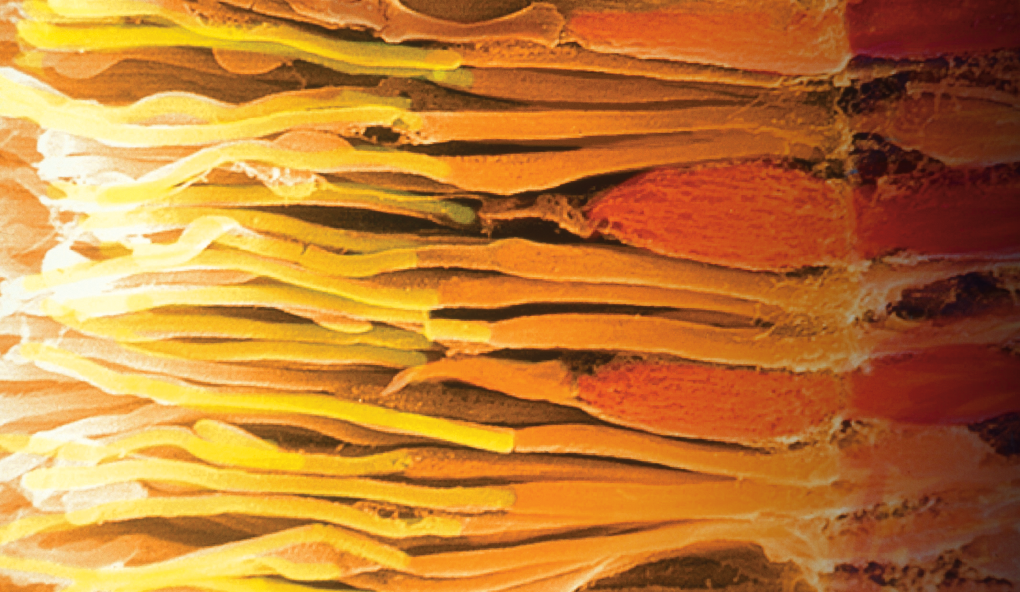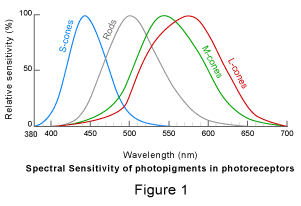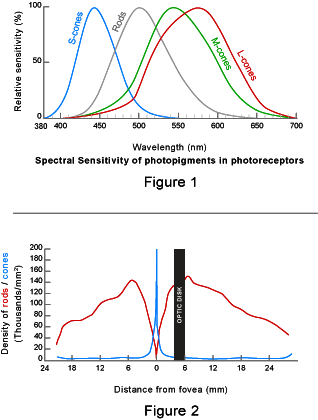Chapter 2. Spectral Sensitivity of Photopigments
2.1 Title slide

Spectral Sensitivity of Photopigments
Control the wavelength and intensity of light striking the retina, and monitor the responses of the four types of photoreceptors.
CLICK ANYWHERE TO BEGIN
Photo: Ralph C. Eagle, Jr./Photo Researchers, Inc./Science Source.
What Is the Spectral Sensitivity of the Photopigments in Rods and Cones?
There are one type of rod and three types of cones, and each of these four types of photoreceptors contains a different kind of photopigment, a molecule with the ability to absorb light and thereby initiate transduction. The four kinds of photopigment molecules differ in their spectral sensitivity—that is, in their ability to absorb light of different wavelengths (perceived as different colors), as shown in Figure 1.

The photopigment in S-cones is most sensitive to short-wavelength light, with a peak sensitivity at 443 nm; S-cones are quite insensitive to wavelengths greater than about 550 nm. The photopigments in M-cones and L-cones both have some sensitivity across nearly the entire spectrum of visible light, but the sensitivity of M-cones is greater toward the middle wavelengths (peaking at 543 nm), while that of L-cones is greater toward the longer wavelengths (peaking at 574 nm). The photopigment in rods is most sensitive to light with a wavelength of 500 nm. Note that these curves show the relative sensitivity of each photopigment (i.e., relative to its maximal response, 100%). The absolute sensitivities of the photopigments differ greatly—for example, maximum rod sensitivity is much greater than maximum M-cone sensitivity, which is why rods support vision under low-light conditions.
Rods and cones are distributed across the retina very differently, and neither distribution is uniform (see Figure 2). There are no rods at all in the fovea, while the density of cones there is very high. The density of cones falls off very rapidly with distance from the fovea and remains at a low level throughout the rest of the retina. The density of rods rises rapidly within a short distance of the fovea and then declines gradually. These distribution patterns of rods and cones reflect their different functions—cones for high-acuity daylight vision, rods for low-acuity but very light-sensitive night vision.

2.2 Explain
An L-cone, an M-cone, an S-cone, and a rod are connected to electrodes, so you can monitor the rate at which these transduce different intensities and wavelengths of light. Choose “Bright” or “Dim” to change the intensity of the light being projected by the spotlight. Drag the slider to change the wavelength. In bright light, only the cones transduce light, because bright light causes rods to stop responding. In dim light only the rod transduces light, because cones don’t respond to dim light.
2.3 Explain
What Is the Spectral Sensitivity of the Photopigments in Rods and Cones?
Rods and cones both transduce light into neural signals. Signals from cones carry
information about differences in wavelength (color) and support high visual acuity (especially the densely packed cones in the fovea). Rods are
much more sensitive than cones to low levels of light but support only poor acuity and carry little information about color. These differences
mean that we use our rods mainly to see in dim light (night vision) and our cones to see in bright light (daylight vision).
There are one type of rod and three types of cones, and each of these four types of photoreceptors contains a different kind of photopigment, a
molecule with the ability to absorb light and thereby initiate transduction. The four kinds of photopigment molecules differ in their spectral
sensitivity—that is, in their ability to absorb light of different wavelengths (perceived as different colors), as shown in Figure 1.
The photopigment in S-cones is most sensitive to short-wavelength light, with a peak sensitivity at 443 nm; S-cones are quite insensitive to
wavelengths greater than about 550 nm. The photopigments in M-cones and L-cones both have some sensitivity across nearly the entire spectrum of
visible light, but the sensitivity of M-cones is greater toward the middle wavelengths (peaking at 543 nm), while that of L-cones is greater
toward the longer wavelengths (peaking at 574 nm). The photopigment in rods is most sensitive to light with a wavelength of 500 nm. Note that
these curves show the relative sensitivity of each photopigment (i.e., relative to its maximal response, 100%). The absolute sensitivities of the photopigments differ
greatly—for example, maximum rod sensitivity is much greater than maximum M-cone sensitivity, which is why rods support vision under low-light
conditions.
Rods and cones are distributed across the retina very differently, and neither distribution is uniform (see Figure 2). There are no rods at all
in the fovea, while the density of cones there is very high. The density of cones falls off very rapidly with distance from the fovea and
remains at a low level throughout the rest of the retina. The density of rods rises rapidly within a short distance of the fovea and then
declines gradually. These distribution patterns of rods and cones reflect their different functions—cones for high-acuity daylight vision, rods
for low-acuity but very light-sensitive night vision.

2.4 Test - single choice
Select your answer to the question below. Then click SUBMIT.
Question
6Pi0KyaZisaycvxdECORS3bksX4dLFMCWRcFVTXALOwO5rRAhWG6qvHvoa9hCTZWz4FHqbEwW3vt3C/wXVuVhyqZYMWSdXZXTwdm3WJLLvYZypzaA6Q1/9LOgu7kGYdKMU9n+GmJiIP/VUn3RNS8f/mrz+bU2cRkh92rGn0Q4JZgXu6MtiS/Ywms4cLnq8Zb95peeOqOIxyVeuKJW0BZPPUr1msC8MhfWfBBu4nVJfVUYtJnuJuWSesVoSnyPQt9/awJRJTC/+7gFFgPy8DG7UlcRF2YBQbtZjUF0rAF45RBrYAlJThAVDpTGgKOAnp4OP8u4O7SrHJ9eqqZxesp422SNrhsRct8XelcKmG2UiOs9hPq8/r+1uBdytZ5amvjdcSJZZesaPDcTFbStjIJ3rkOkij3Uq8GqsN86AnzU2Y3KtvIWh2p6PWQqIWZ8y0VarIyGwo5lu6jjmHT92iSNeTvlihyzkI23gQlOKwB7SWeKEcT3PG5P700Hmmt/ntNhkQTgMWzKeRidYgKagoWk0K8WO95wb/JlaSo4b/McnXyvr+0DrPsX9jGiWnJcpjwc5v24YphXfn0Rl1BKsSeP6MzQDDHotsWZZOe5mbjCTGdI1q45qbU0iurPJclTojAXY+2cxfQM+Uny3QC/UmHlH9PspoiEZWWxJ94XzzrQzZ1f6igM1o+WyyDh7G/uQWq/qAFRQcPaxsXPYRjagBhmOuSV8hwu7VCyK9A5r9+hE6zLlw0tsLN2bDZL1rn9oe6//tpVRcBDxwiAN1IPVzBDqmDF4uqZ3KPpKjDrHoVy+DXU+/aJrwewkf2H77MUy4I27DT+CYA2lsWJU4QaK2O59edz44uAxKl+LQu9e2+wedtvQEFO6V0BaKmT//AvJNHpWyyVzUTbX07SJoqeLucgwPbrIcUjz8YPksAsxNTshHbiRc/KSftieDJxbtOI9AWUYcuOXFGlZ/cXVVi4xanem70+uokwpRyPs9c+QVoencvXwg8DhTR33YLlKcO5q6piUeef+3qX1/3lboG3xpAZYRCmKIjDFvF6a/8G8oPomy7h0aLz+sLig==2.5 Test - single choice
Select your answer to the question below. Then click SUBMIT.
Question
6pXDGBdSXTglvwYUPjIuFQtPHIJ7pPBAQUJ1vCv6wPs+ywEsAZjcJAVrTn4KSS2PDCEBlR30yD6jWpqu5rbuQhQMXlVf755bkOaOAqRSesUvezko1FdARQ1LNz/MNZ2J6l46y1WkOhJvDV5LJTcBXPwh3AvnV5I0vMIDy9qwjGGbEYybedzkxGb6bcRrF14Uf2qmFmZs+On41YJck2H4x3VR+jbRygERhka3byLbuOSlflqu2JVt82CFyjBFRqGBBXY1d/gXpR5tdWicDv5jRleJt//5XdQX545X4VghlGzBQjhtHYFyWEI/j4RnEyot7umq/F82JIEwkosDLlCGlwtR7/Isrtv3SrTzDDyoRiagsYaY7a5uUqNNK6A0aweKSfX17+ns+nbYtIvBkaweVkoburS9EWaGBToivmSys/6hIK8GVROVFb2TvyyDTnSS+//gmwRRTnJe11C5yxvo9n0Qo6ZSl+qpSzczKAchVDREcZwkst9VhzeRXH2UhtzWub8SO3GgIuIR4kjiCUGezHiJSs3c9ta2OExoFr8xbJaJg117JY6EkBQ5sbjtReTkTf5j0/cRWdfDdZjzvIW4FSqt35VV0hm8PBs8JABrLbZXk02dlV/5o6V5oMkUxg9VqwbMycOKqzeARjrPQjcqBYGeaxv4uy4tnbzh9qD9oqGUguVuBZYv+2cTHFCyMAEoPEXlPJ+3KsTSErFEhJ9VgFCEYRX+RByQAnm35A==2.6 Test - dnd
Drag each label into the blank box below the matching description. Then click SUBMIT.